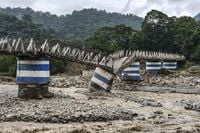The picturesque hills of Darjeeling, often celebrated for their lush tea gardens and misty vistas, have been left reeling after a series of deadly landslides and floods triggered by relentless October rains. According to multiple reports from the Geological Survey of India (GSI), local officials, and political leaders, the disaster unfolded over the night of October 4 and into the morning of October 5, 2025, as saturated Himalayan slopes buckled under the strain of extreme rainfall, leaving devastation in their wake.
On October 4, the GSI issued an orange-level landslide warning for Darjeeling at approximately 2:15 pm, mere hours before the region was battered by torrential downpours. Dr. Saibal Ghosh, Deputy Director General of the GSI and an expert in engineering geology and landslide science, explained the urgency behind the forecast. “We had provided a landslide forecast in Darjeeling Pulbazar, Jorebunglow Sukiapokhri, Kurseong, Mirik and Rangli Rangliot blocks of Darjeeling district in the afternoon of October 4. It was an operational bulletin issued around 2.15 pm,” Ghosh told the media, as reported by PTI.
The GSI’s daily bulletins, available both on its ‘Bhusanket’ web portal and the ‘Bhooskhalan’ mobile app, are released during the monsoon season for districts considered highly prone to landslides. Darjeeling, along with Kalimpong, Nilgiris, and Rudraprayag, receives these operational warnings that are also accessible to the public. “We issue this bulletin every day during the monsoon. Apart from these four districts, we also provide bulletins to 17 other districts in eight states — but only to respective state governments — for validation and data collection,” Ghosh noted.
What made this event especially catastrophic, according to GSI, was the timing and intensity of the rainfall. The monsoon in the Himalayas stretches from June to October, leaving the soil waterlogged and unstable by the time October arrives. “In the Himalayas, the monsoon period is from June to October. During this time, the risk of landslides is always high because of the volume of rainfall. But October rainfall is especially dangerous, because the soil is already fully saturated,” Ghosh observed. The Kurseong area alone recorded a staggering 393 mm of rainfall between October 4 and 5. “Basically, rainfall between 130 mm and 150 mm in a single day can trigger a landslide. If such heavy rainfall occurs in October, then it is very dangerous for places like the Himalayas,” he said. “Because after four months of monsoon rains, the soil is already saturated. Even moderate rain can trigger major slides, and here we had an extreme downpour.”
The consequences were immediate and tragic. According to district authorities, at least 18 people were reported killed in Darjeeling due to the incessant rains, with 11 deaths in Mirik, four in Jorebunglow, two in Sukhia Pokhari, and one in Darjeeling Sadar confirmed by October 5. West Bengal Chief Minister Mamata Banerjee, during her visit to the site of the Dudhia bridge collapse in Mirik on October 7, stated that the overall death toll in North West Bengal had reached 27, including one Nepali and one Bhutanese national. “The disaster is man-made, flash flood, landslide with heavy rain. 27 people, including one Nepali and one Bhutanese, have lost their lives in this incident. All departments are working very hard in the rescue mission. Restoration work is already underway in Nagrakata, Mirik,” Banerjee said, as reported by local media.
The destruction extended beyond the loss of life. Homes and infrastructure were swept away, with rivers like the Balason swelling furiously and damaging key structures such as the Iron Bridge at Dudhiya. Banerjee highlighted the scale of the crisis: “So many bridges are choked. Infrastructure is damaged. We have not been getting funds from the Centre for 5 years. Awas Yogana, Mahatma Gandhi NREGA has been stopped for the last 5 years. Double-engine governments receive money, but not the West Bengal government. We don't want people to suffer because of this. It will take time, but we will revive it.”
Union Minister Kiren Rijiju visited the flood and landslide-affected areas on October 8, inspecting the losses and interacting with survivors. He called for a stronger response from the state government. “From what we have seen so far and as per reports, the impact of the rains in Darjeeling has been huge. There has been an immense loss of life and property. Local representatives and administration are doing all they can, but the state government needs to step up its relief measures. The CM came to Siliguri to meet the victims of the disaster, but we want the state government to map the disaster... Those affected by the disaster, who have lost their livelihood and homes, should be provided relief and rehabilitated. This will be a challenge,” Rijiju said.
BJP MLA Neeraj Zimba was even more critical, stating, “The state government has not declared an emergency so far after this disaster. There's a huge difference between Kolkata and Darjeeling. They consider Darjeeling to be merely a tourist spot, not their own. They are extremely careless in handling issues here. What has happened has happened. They cannot bring back the lives that have been lost, but those who have survived need to be rehabilitated. We will do whatever we can, but it is the prerogative of the state government; the onus lies on them.”
Experts have pointed out that the Himalayan region is inherently unstable, being a geologically young mountain chain with fractured rock formations and steep slopes. “Landslides are gravitational processes. Hillsides are naturally prone to collapse, but whether a slope will fail depends on both intrinsic geological conditions and external triggers like rainfall, earthquakes, or human activity,” Ghosh explained. He also drew historical parallels, referencing the catastrophic October 1968 landslides that killed 677 people after 1,121 mm of rain fell in three days, burying roads for over a year. “All the major roads were filled with muck, and it took 1.5 years to remove it,” he recalled.
Human activity has only compounded the risk. “People are building homes across drainage channels, blocking natural water paths. These practices, combined with heavy rain, make landslides inevitable. The state must step in with strict regulations,” Ghosh warned.
While local representatives and administration have begun relief and restoration work, the path to recovery will be long and arduous. The disaster has reignited debates over disaster preparedness, environmental management, and the need for coordinated action between state and central authorities. As Darjeeling mourns its losses, the hills stand as a stark reminder of the delicate balance between nature and human ambition—a balance that, when tipped, can have devastating consequences.





